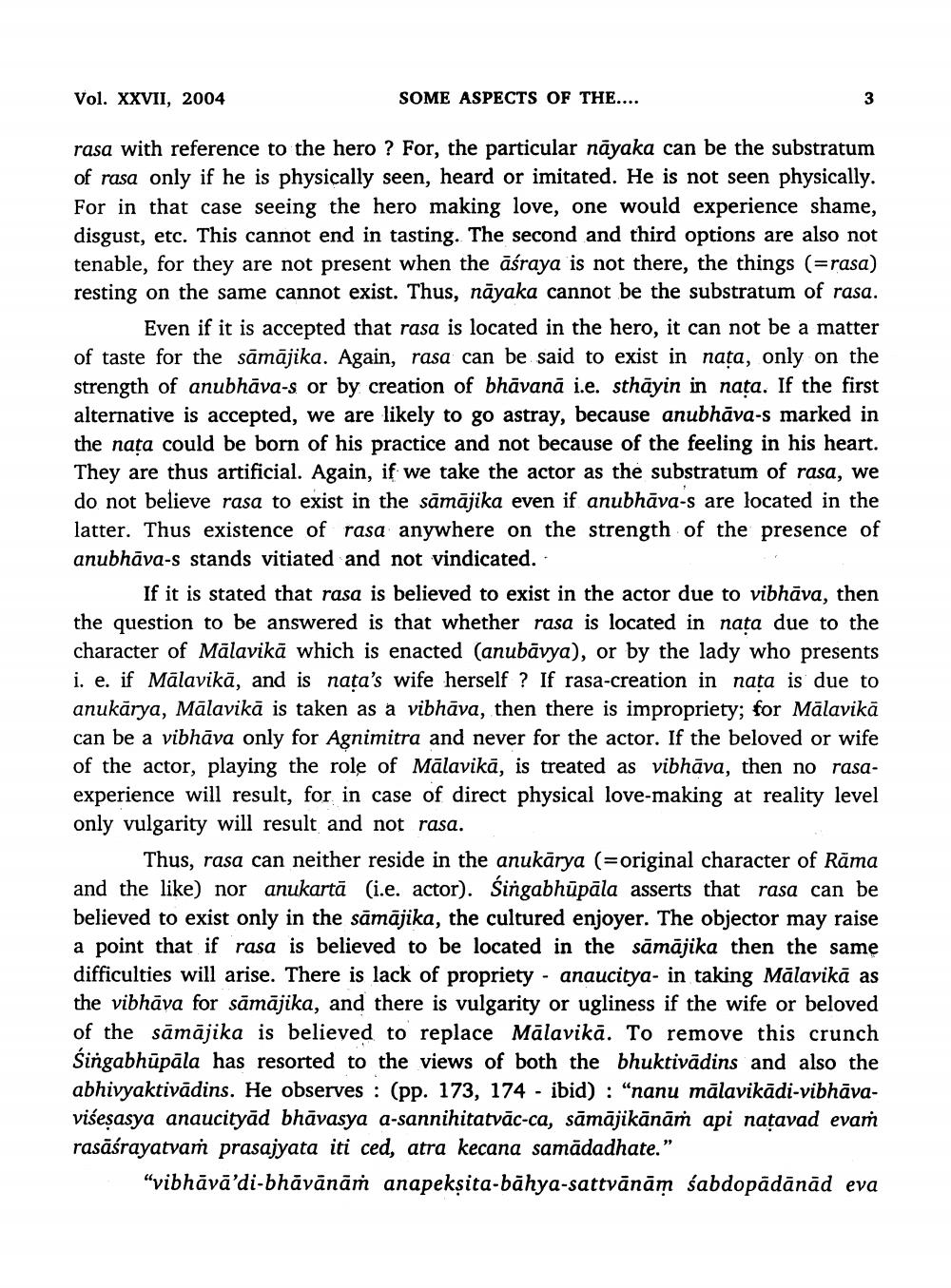Book Title: Sambodhi 2004 Vol 27 Author(s): J B Shah, N M Kansara Publisher: L D Indology Ahmedabad View full book textPage 9
________________ Vol. XXVII, 2004 SOME ASPECTS OF THE.... rasa with reference to the hero ? For, the particular nayaka can be the substratum of rasa only if he is physically seen, heard or imitated. He is not seen physically. For in that case seeing the hero making love, one would experience shame, disgust, etc. This cannot end in tasting. The second and third options are also not tenable, for they are not present when the aśraya is not there, the things (=rasa) resting on the same cannot exist. Thus, nāyaka cannot be the substratum of rasa. Even if it is accepted that rasa is located in the hero, it can not be a matter of taste for the sāmājika. Again, rasa can be said to exist in nata, only on the strength of anubhāva-s or by creation of bhāvanā i.e. sthāyin in nata. If the first alternative is accepted, we are likely to go astray, because anubhāva-s marked in the nata could be born of his practice and not because of the feeling in his heart. They are thus artificial. Again, if we take the actor as the substratum of rasa, we do not believe rasa to exist in the sāmājika even if anubhāva-s are located in the latter. Thus existence of rasa anywhere on the strength of the presence of anubhāva-s stands vitiated and not vindicated. If it is stated that rasa is believed to exist in the actor due to vibhāva, then the question to be answered is that whether rasa is located in nata due to the character of Mālavikā which is enacted (anubavya), or by the lady who presents i. e. if Mālavikā, and is nata's wife herself ? If rasa-creation in nata is due to anukārya, Malavikā is taken as a vibhāva, then there is impropriety; for Mālavikā can be a vibhāva only for Agnimitra and never for the actor. If the beloved or wife of the actor, playing the role of Mālavikā, is treated as vibhāva, then no rasaexperience will result, for in case of direct physical love-making at reality level only vulgarity will result and not rasa. Thus, rasa can neither reside in the anukārya (=original character of Rāma and the like) nor anukartā (i.e. actor). Śingabhūpāla asserts that rasa can be believed to exist only in the sāmājika, the cultured enjoyer. The objector may raise a point that if rasa is believed to be located in the sāmājika then the same difficulties will arise. There is lack of propriety - anaucitya- in taking Mālavikā as the vibhāva for sāmājika, and there is vulgarity or ugliness if the wife or beloved of the sāmājika is believed to replace Malavikā. To remove this crunch Singabhūpāla has resorted to the views of both the bhuktivādins and also the abhivyaktivādins. He observes : (pp. 173, 174 - ibid) : "nanu mālavikādi-vibhāvavišeşasya anaucityād bhāvasya a-sannihitatvāc-ca, sāmājikānām api natavad evaṁ rasāśrayatvam prasajyata iti ced, atra kecana samādadhate.” "vibhāvā'di-bhāvānāṁ anapeksita-bāhya-sattvānām sabdopādānād evaPage Navigation
1 ... 7 8 9 10 11 12 13 14 15 16 17 18 19 20 21 22 23 24 25 26 27 28 29 30 31 32 33 34 35 36 37 38 39 40 41 42 43 44 45 46 47 48 49 50 51 52 53 54 55 56 57 58 59 60 61 62 63 64 65 66 67 68 69 70 71 72 73 74 75 76 77 78 79 80 81 82 83 84 85 86 87 88 89 90 91 92 ... 212
